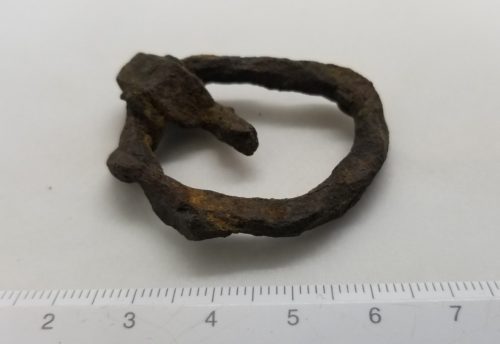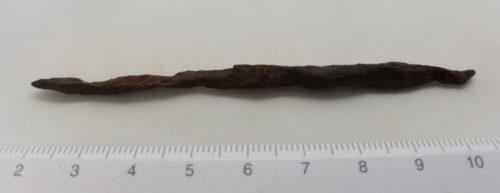Pagan Perspectives
A farmstead from the Viking Age was found earlier this month by a local resident in Þjórsárdalur, a valley in the southern highlands of Iceland.
Bergur Þór Björnsson is the great-grandson of the man who discovered the region’s most recently found Viking-era farm back in 1920. With his new find, the total number of known farms stands at twenty-one.
Archaeologists from Fornleifastofnun Ísland (“the Institute of Archaeology in Iceland”) were called to the scene and soon found several small objects. Among them was a Thor’s hammer amulet, only the second ever found in Iceland. Adolf Friðriksson, director of the Institute, told me that record searches so far suggest that this is the first Mjölnir pendant made of stone found anywhere.

A stone Thor’s Hammer found in Þjórsárdalur [courtesy Fornleifastofnun Ísland].
The Wild Hunt: How did the explosion of the Hekla volcano in 1104 affect farms in the Þjórsárdalur area?
Ragnheiður Gló Gylfadóttir: This is not an easy question to answer. The valley wasn’t deserted all at the same time.
The tephra[1] layer from 1104 likely covered the valley, but there is evidence of habitation in the valley until the twelfth century. One of the farms, for example, fell out of use in the late sixteenth century, and two farms are still in habitation.
TWH: Have any other farms in this area been excavated?
RGG: This deserted valley has held a central place in Icelandic archaeology for nearly one and a half centuries. It’s often referred to as “Iceland’s Pompeii.” There are about fifteen to twenty known Viking Age sites and farms in the valley, and the first excavations there took place in the late 1890s.
In 1939, a team of Nordic archaeologists came to Iceland to investigate Viking Age and medieval house structures as the key to understanding the development of Nordic building custom. At the time, six farms were excavated in Þjórsárdalur, Stöng the most famous of them.
Since then, there has been lively – and sometimes vicious – debate on the dating of the abandonment of the valley. A number of “follow-up” excavations have been carried out, the last one in 2000-2001.
In total, about two thousand artifacts from the farms have been found, dating mostly from the ninth to twelfth century.

A whetstone found in Þjórsárdalur [courtesy Fornleifastofnun Ísland].
RGG: Yes, they have. Some parts of the valley are now covered in forest, and some sites are “gone” as the result.
TWH: How did Bergur Þór Björnsson discover the Bergstaðir farm site?
RGG: He was born and raised in a farm in Þjórsárdalur, one of the two that is in habitation in the valley. He felt there was “a gap” in the distribution of the Viking age farms and decided to try to find some evidence of habitation there.
TWH: What is the protocol for investigation and collection when you receive information about a new find like that from Bergur?
RGG: The Cultural Heritage Agency of Iceland should be informed about any archaeological sites, finds, or artifacts as soon as possible. If some artifacts are found they should be turned over to the National Museum of Iceland.
The Institute of Archaeology, where I work, has no role when people find new things or archaeological sites in Iceland. The Institute is privately owned, and we do both research and commercial work.
We were working in Þjórsárdalur for the local municipality when we talked to Bergur, and he informed us about the site. The project involved measuring up and surveying all known archaeological sites in the municipality, also outside Þjórsárdalur.
Of course, we followed the laws and reported the farm and the finds to The Cultural Heritage Agency. The finds go to the National Museum.
All the finds were measured in situ with a total station[2], and the midden[3] as well. We hope to do more research in the area later. No excavation has been done there yet.

A buckle found in Þjórsárdalur [courtesy Fornleifastofnun Ísland].
RGG: The site is eroded and no structures are visible on the surface. We found a midden. A big part is likely eroded away. There is also evidence of a smithy. Slag is lying on the surface there.
TWH: Iceland Magazine reports that “[w]hen archeologists arrived at the scene they could immediately see that Bergur was right: The foundation of a Viking Age longhouse were clearly visible in the ground, as well as various other remains” (sic). Can you clarify what you saw at the site?
RGG: There were no structures, only a few stones and the midden, and slag where the smithy probably was.
TWH: Can you explain what objects have been found so far?
RGG: The objects were found in the midden and the smithy, lying on the surface. We found a Thor’s hammer amulet, whetstones, part of a soapstone pot, and iron buckles. I can’t explain why these items were there at this time.
TWH: In the photograph I’ve seen, the Thor’s hammer amulet appears to have runes carved into it. Do you think that’s what they are?
RGG: These are not runes, or so we believe at this time. The amulet is made of sandstone and therefore scratches easily. It’s been lying in the ground for about 1100 years, among sharp pumice stones from eruptions in Hekla.
TWH: Does the Thor’s hammer have a hole in the shaft to be strung as an amulet?
RGG: No, the hole or the shaft is broken and missing from the amulet.

An awl found in Þjórsárdalur [courtesy Fornleifastofnun Ísland].
RGG: We don´t know when the farm was deserted. Tephra from different eruptions is on the surface, and no excavations have been done. The farm, like big parts of Þjórsárdalur, is eroded and the soil moves around easily.
TWH: What happens to the objects now?
RGG: They will go to the National Museum of Iceland, Þjóðminjasafn Íslands.
TWH: What are the institute’s plans for further excavation?
RGG: We hope to excavate the site and do further research there. The site is very interesting, and no other midden is known in Þjórsárdalur.
[1] Fragments of dust and rock propelled into the air by a volcanic eruption.
[2] An electronic device which simultaneously measures horizontal and vertical position of an object.
[3] A refuse pile.
Thanks to Ragnheiður Gló Gylfadóttir for being so generous with her time and to Adolf Friðriksson, Director of Fornleifastofnun Íslands, for his kind help and permission to use the official photographs of the objects.
* * *
The views and opinions expressed by our diverse panel of columnists and guest writers represent the many diverging perspectives held within the global Pagan, Heathen and polytheist communities, but do not necessarily reflect the views of The Wild Hunt Inc. or its management.
The Wild Hunt is not responsible for links to external content.
To join a conversation on this post:
Visit our The Wild Hunt subreddit! Point your favorite browser to https://www.reddit.com/r/The_Wild_Hunt_News/, then click “JOIN”. Make sure to click the bell, too, to be notified of new articles posted to our subreddit.